Magnetic Effects of Electric Current Class 10 Notes Science Chapter 12
Introduction
Magnet
A magnet is a material that generates a magnetic field, enabling it to attract or repel other materials with magnetic properties. For example, lodestone, a natural magnet, can attract materials such as iron, nickel, and cobalt.
Every magnet possesses two poles—north and south—which are inseparable. When suspended freely, the north pole of a magnet aligns itself with the Earth's geographic north. Similar to electric charges, magnetic poles exhibit the properties of attraction and repulsion: like poles repel each other, while opposite poles attract.

- An electric current-carrying wire behaves like a magnet. Electromagnets and electric motors involve the magnetic effect of electric current, and electric generators involve the electric effect of moving magnets.
- Compass needle get deflected on passing an electric current through a metallic conductor.

Bar Magnet
- A bar magnet is a solid, typically rectangular object made of materials like iron, steel, or other ferromagnetic substances, with natural magnetic properties.
- It has two distinct poles: a north pole and a south pole.
- When freely suspended, the north pole aligns with the Earth’s geographic north.
- Picture a rectangular iron bar magnet with two ends: one being the north pole and the other the south pole.
- When suspended, its north pole always points toward the Earth’s north pole.
- This characteristic makes it crucial for navigation, as demonstrated by its use in magnetic compasses.
- The bar magnet’s behaviour highlights its inherent magnetic properties and clearly defined poles.
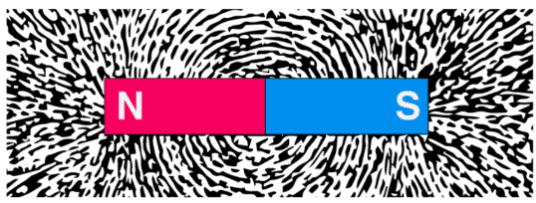
Properties of Magnet

(i) Every magnet has two poles i.e. North and South.
(ii) Like poles repel each other.
(iii) Unlike poles attract each other.
(iv) A freely suspended bar magnet aligns itself in nearly north-south direction, with its north pole towards north direction.
Magnetic Field and Field Lines
- Magnetic field is a quantity that possesses both size and direction.
- The orientation of the magnetic field is determined by the movement of a north pole of a compass needle within it.

- As a convention, it is assumed that the field lines emerge from the north pole and converge at the south pole.
- Within the magnet, the field lines flow from the south pole to the north pole, forming closed loops.
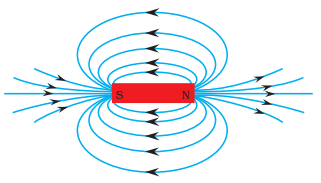
- The intensity of the magnetic field is depicted by the proximity of the field lines. A denser concentration of lines indicates a stronger field, resulting in greater force on the pole of another magnet placed in that area.
- It is observed that field lines do not intersect. If they did, it would suggest that at the point of intersection, the compass needle would indicate two directions, which is impossible.
Magnetic Field of a Bar Magnet
- H. C. Oersted was the first person to state that electric current has magnetic field.
- Think of a magnetic field as an invisible force that surrounds a magnet.
- This field is what causes magnets to attract or repel other objects.
- Imagine the force you feel when you bring two magnets close to each other.
- This force spreads out around the magnet and influences nearby objects.
- When we mention a magnetic field, we are referring to this invisible area around a magnet where its power can be sensed.

Magnetic Field Due to a Current-Carrying Conductor
Magnetic Field due to Current through a Straight Conductor
- Concentric circles can represent it at every point on conductor.
- Direction can be given by right-hand thumb rule or compass.
- Circles are closer to the conductor.
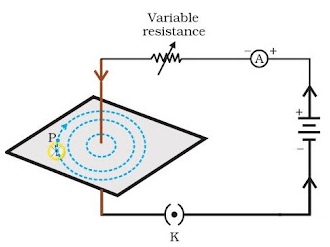
- When you change the current in a copper wire, the compass needle placed nearby also changes its direction.
- If you increase the current, the needle's deflection increases as well, showing that the magnetic field's strength at that point rises with the current.
- If you move the compass away from the wire while keeping the current constant, the needle's deflection decreases.
- Magnetic field ∝ Strength of current.
- This change happens because the magnetic field weakens as you move farther from the wire.
- Magnetic field ∝ 1/Distance from conductor
Right-Hand Thumb Rule
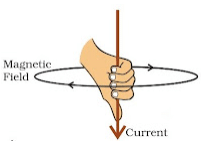
- Imagine you are holding a current carrying straight conductor in your right hand such that the thumb is pointing towards the direction of current.
- Then the fingers wrapped around the conductor give the direction of magnetic field.
Magnetic Field due to Current through a Circular Loop
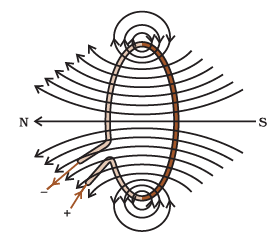
- Just like how the magnetic field around a straight wire varies with distance, the field around a circular loop forms concentric circles that expand as you move away.
- As you approach the centre of the loop, these circles appear as straight lines.
- Each point on the wire contributes to straight magnetic field lines at the loop's centre, all in the same direction.
- Using the right-hand rule, we can confirm that each wire segment adds to the magnetic field within the loop.
- The strength of the magnetic field at a point due to a current-carrying wire is directly proportional to the current flowing through it.
- If a coil has multiple turns, the resulting field is stronger, as each turn's field adds up due to the consistent current direction.
Factors affecting magnetic field of a circular current carrying conductor
- Magnetic field ∝ Current passing through the conductor
- Magnetic ∝ 1/Distance from conductor
- Magnetic field ∝ No. of turns in the coil

- Magnetic field is additive in nature i.e., magnetic field of one loop adds up to magnetic field of another loop. This is because the current in each circular turn has some direction.
Magnetic Field due to a Current in a Solenoid
- A solenoid is a coil made of many circular loops of insulated copper wire wrapped tightly in a cylinder shape.
- One end of the solenoid acts like a magnetic north pole, while the other end acts like a south pole.
- Within the solenoid, the magnetic field lines are straight and parallel, showing uniformity throughout.
- Due to this uniformity, a strong magnetic field is created inside the solenoid, capable of magnetizing materials like soft iron when placed within the coil
- The resultant magnet is termed an electromagnet.
Direction of magnetic field
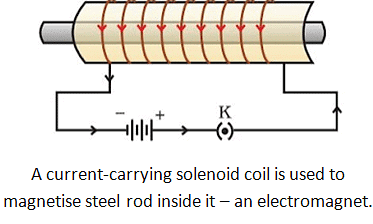 (i) Outside the solenoid: North to South
(i) Outside the solenoid: North to South
(ii) Inside the solenoid: South to North
Solenoids can be used to magnetise a magnetic material like soft iron.
Force on a Current carrying Conductor in a Magnetic Field
- French scientist Andre Marie Ampere (1775–1836) proposed that a magnet also exerts a matching force on a current-carrying conductor.
- When an aluminium rod carrying current is placed in a magnetic field, it experiences a force, as indicated by the rod's movement.
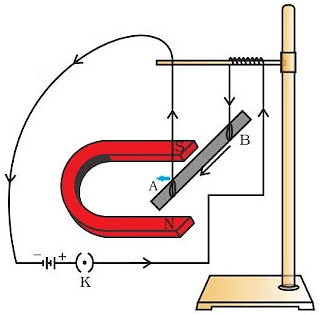
- The force's direction changes when the current's direction in the conductor is reversed.
- Upon flipping the magnet's poles to make the field point downward, the force direction on the rod reverses once more.
- This demonstrates that the force's orientation on the conductor relies on both the current's direction and the magnetic field's direction.
- Experiments reveal that the greatest rod displacement (or force magnitude) occurs when the current is perpendicular to the magnetic field.
- In such a scenario, a simple rule can be applied to determine the force's direction on the conductor.
Fleming’s Left-Hand Rule
- Stretch the thumb, fore finger and middle finger of your left hand such that they are mutually perpendicular.
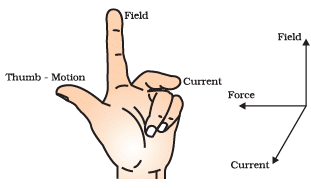
- If the finger points in the direction of the magnetic field and the middle finger in the direction of the current, then the thumb will point in the direction of motion or force.
- The heart and brain in the human body have significant magnetic fields.
- MRI (Magnetic Resonance Imaging): An image of internal organs of the body can be obtained using the magnetic field of the organ.
- Galvanometer: Instrument that can detect the presence of current in a circuit. It also detects the direction of the current.
Domestic Electric Circuits
There are three kinds of wires used:- Live wire (positive) with red insulation cover.
- Neutral wire (negative) with black insulation cover.
- Earth wire with green insulation cover.
The potential difference between live and neutral wire in India is 220 V.
Pole ⇒ Main supply ⇒ Fuse ⇒ Electricity meter ⇒ Distribution box ⇒ To separate circuits

- Earth Wire: Protects us from electric shock in case of current leakage, especially in metallic body appliances. It provides a low resistance path for current in case of leakage of current.
- Short Circuit: When live wire comes in direct contact with neutral wire accidentally. The resistance of the circuit becomes low, which can result in overloading.
- Overloading: When the current drawn is more than the current carrying capacity of a conductor, it results in overloading.
Causes of overloading
- Accidental hike in voltage supply.
- Use of more than one appliance in a single socket.
Safety devices
- Electric fuse
- Earth wire
- MCB (Miniature Circuit Breaker)
|
80 videos|569 docs|80 tests
|
FAQs on Magnetic Effects of Electric Current Class 10 Notes Science Chapter 12
| 1. What are the main properties of magnets? |  |
| 2. How is a magnetic field represented, and what are field lines? |  |
| 3. What is the magnetic field due to a straight current-carrying conductor? |  |
| 4. How does a magnetic field exert a force on a current-carrying conductor? |  |
| 5. What are the key components of a domestic electric circuit? |  |

















